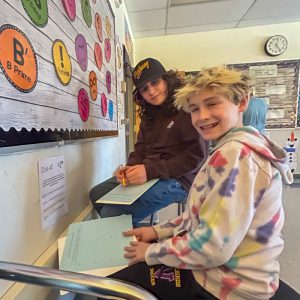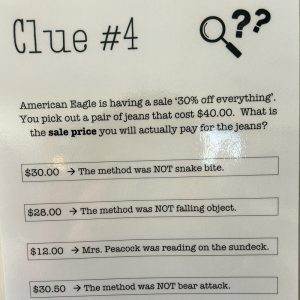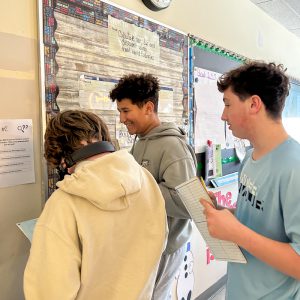
 Numbers come to life in Allysa Seaburg’s 7th-grade math class through mysteries and other activities that get students out of their seats and collaborating to solve real-world math problems. Recently, students played detective, solving math problems involving tax, tip and discount to earn clues in a manner similar to collecting data for the board game Clue.
Numbers come to life in Allysa Seaburg’s 7th-grade math class through mysteries and other activities that get students out of their seats and collaborating to solve real-world math problems. Recently, students played detective, solving math problems involving tax, tip and discount to earn clues in a manner similar to collecting data for the board game Clue.
The thrill of completing a puzzle can be a powerful learning tool. “Anything that is a mystery, gets students interested in solving it,” Seaburg noted. Student Gianna T. agreed. “Finding out who committed the crime makes it fun,” she said.
Parker J., another student, also enjoyed solving the math mystery. “It’s similar to a board game,” he said. He added that he likes working with friends to solve mysteries.
 Each week, after she introduces new concepts, Seaburg tries to follow up learning while seated with a real-world activity that gets students up and moving around. These activities promote critical thinking and problem solving while providing a real-world application of knowledge.
Each week, after she introduces new concepts, Seaburg tries to follow up learning while seated with a real-world activity that gets students up and moving around. These activities promote critical thinking and problem solving while providing a real-world application of knowledge.
Going from station to station in the classroom, students used calculators and mental math to solve problems involving tax, tip and discount to reveal a clue to the mystery.  Gianna said she found computing tax and sale prices more challenging than calculating tips. Parker noted that the calculations could be tough, but agreed solving the math mysteries helps build confidence.
Gianna said she found computing tax and sale prices more challenging than calculating tips. Parker noted that the calculations could be tough, but agreed solving the math mysteries helps build confidence.
The students weren’t the only ones making discoveries. Seaburg used the activity to observe how her students are grasping the concepts. ”It’s a great way for them to demonstrate that they understand the concepts,” she said.
